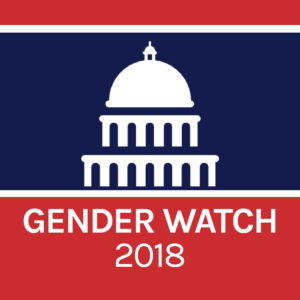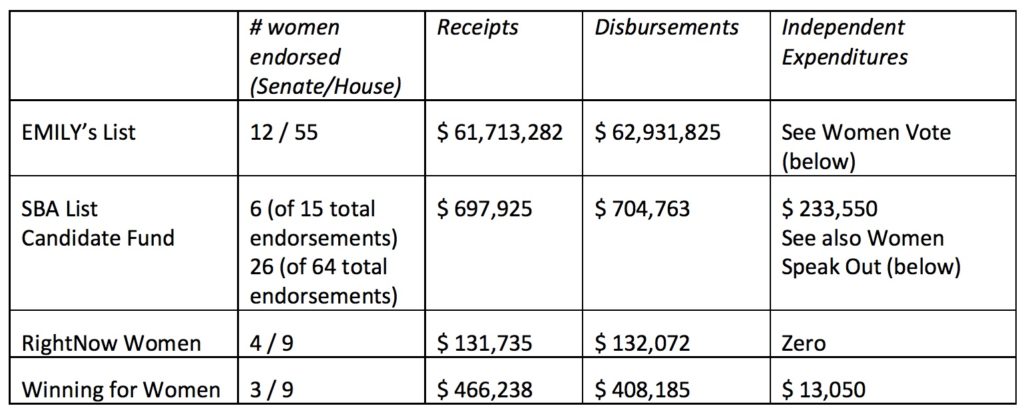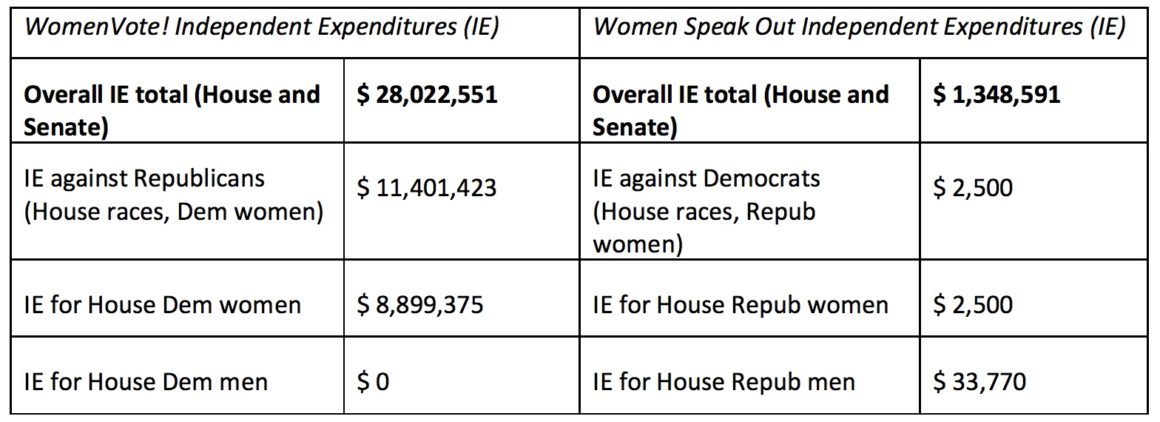Women Donors and Women’s PACs Deliver for Democratic, not Republican, Women Candidates in 2018
 From March to December 2018, the Barbara Lee Family Foundation (BLFF) and the Center for American Women and Politics (CAWP) partnered to offer Gender Watch 2018, which tracked, analyzed, and illuminated gender dynamics in the 2018 midterm elections. With the help of expert scholars and practitioners, Gender Watch 2018 furthered public understanding of how gender influences candidate strategy, voter engagement and expectations, media coverage, and electoral outcomes in campaigns. The blog below was written for Gender Watch 2018, as part of our collective effort to raise questions, suggest answers, and complicate popular discussions about gender’s role U.S. elections.
From March to December 2018, the Barbara Lee Family Foundation (BLFF) and the Center for American Women and Politics (CAWP) partnered to offer Gender Watch 2018, which tracked, analyzed, and illuminated gender dynamics in the 2018 midterm elections. With the help of expert scholars and practitioners, Gender Watch 2018 furthered public understanding of how gender influences candidate strategy, voter engagement and expectations, media coverage, and electoral outcomes in campaigns. The blog below was written for Gender Watch 2018, as part of our collective effort to raise questions, suggest answers, and complicate popular discussions about gender’s role U.S. elections.
In an election cycle that saw an unprecedented number of women running as House candidates, an examination of campaign finance activity by women’s PACs helps explain why Democratic women made significant gains in 2018 while Republican women lost ground. For Democratic women candidates, the fundraising power of women donors and women’s PACs are potent resources from which Republican women candidates do not similarly benefit. This fundraising imbalance exists on two, likely related, fronts: in 2018 women donors gave significantly more money to Democratic women candidates compared to what they gave to Republican women candidates; and, liberal women’s PACs raised and distributed significantly more money to Democratic women than what was raised and distributed by conservative women’s PACs to Republican women candidates. This fundraising imbalance, in existence before the 2018 midterms, suggests that the vastly unequal campaign finance infrastructure available to women candidates will remain a significant challenge for Republican women candidates in forthcoming elections.
The amount of money donated by women to Democratic women candidates increased sharply this year from 2016 when Hillary Clinton was the Democratic presidential nominee. Research by the Center for Responsive Politics that tracks campaign contributions to congressional party candidates by women donors from 1990 to 2018 shows a starting point of near parity (if not a slight advantage for Republican women) in the modest cumulative sums (under $2M each) that women donors gave to Democratic and Republican women candidates. Of course, it is important to note that women donors contributed more overall to men than women congressional candidates through 2016, which reflects the reality that the most congressional races are all-male.
But as women donors’ contributions to Democratic women candidates have ticked upward, they have essentially remained flat to Republican women candidates. In 2018, the Center for Responsive Politics states that women contributed – in aggregate and combining House and Senate totals – $19,092,031 to Republican women congressional candidates and $159,504,806 to Democratic women congressional candidates, and donated more money to Democratic women congressional candidates than to men. These totals are even more astonishing when considering two things: first, women were less than one-third of all Democratic congressional candidates and just 43% of Democratic congressional nominees, but received 52% of women’s donations to Democratic candidates in 2018; second, more than half of Democratic women nominees (compared to just 39% of men) challenged Republican incumbents this cycle, raising valid questions about their capacity to win. This year women donors made clear their preference for Democratic women candidates and more representation by them.
The financial advantage enjoyed by Democratic women congressional candidates compared to their Republican women counterparts was echoed in the campaign finance activity of women’s PACs. In previous work, Melody Crowder-Meyer and I demonstrated that the fundraising imbalance between liberal and conservative women’s PACs in recent congressional and presidential elections benefits Democratic women candidates and disadvantages Republican women. This significant funding gap persists in 2018, as liberal women’s PACs – specifically EMILY’s List – raised and distributed significantly more money to endorsed Democratic women congressional candidates than the combined amounts raised and distributed by multiple conservative women’s PACs – including Susan B. Anthony (SBA) List, RightNow Women and, Winning for Women – on behalf of endorsed Republican women congressional candidates. EMILY’s List raised over $60 million dollars in their mission to elect progressive Democratic women candidates while the three identified conservative women’s PACs combined raised just over $1 million dollars for Republican women candidates.
Susan B. Anthony List, whose mission is to elect pro-life candidates, particularly women, endorsed more Republican men than women candidates in the 2018 cycle. In fact, Republican women candidates accounted for only 40 percent of the candidates endorsed by SBA List; the remaining 60 percent were Republican men. EMILY’s List, RightNow Women, and Winning for Women only endorsed and funded women candidates. These totals and endorsement counts make clear that the amount of funding available to endorsed Democratic women candidates is significantly greater than the amount available to Republican women who, in the case of SBA List, must also compete with the men in their party for funding.
Women’s PAC Fundraising Activity in Congressional Elections, 2018

The disparity in funding to House Democratic and Republican women candidates is even more pronounced when examining independent expenditure totals for EMILY’s List and SBA List. Independent expenditures, sometimes referred to as outside spending, are the unlimited funds that may be raised and spent by PACs to support or oppose a candidate so long as they are not expressly coordinated with a candidate’s campaign. Since 2010, EMILY’s List has raised funds for independent expenditures through a Super PAC called WomenVote!, and since 2012 SBA List has raised funds for independent expenditures through a Super PAC called Women Speak Out. The table below lists the independent expenditures and allocations for the two groups in the 2018 cycle.
WomenVote! and Women Speak Out Independent Expenditures, Totals and Allocation, 2018

As the figures above demonstrate, the funding imbalance between EMILY’s List and conservative women’s PACs expands with independent expenditures. EMILY’s List spent all of those funds on contests featuring Democratic women candidates, while SBA List spent only a fraction of their independent expenditures on Republican women candidates. Specifically, in 2018, EMILY’s List spent over $20 million dollars on independent expenditures in 28 House races featuring Democratic women candidates, the majority of whom were challengers running against Republican men incumbents. In contrast, SBA List spent the majority of its $36,270 in funds allocated to House races on Republican men candidates and directed only $2,500 in independent expenditures to one contest with a Republican woman House candidate, incumbent Representative Virginia Foxx (NC-5). Instead, SBA List directed most of its independent expenditures to endorsed Senate Republican candidates, again, the majority of whom were men. In sum, independent expenditures from liberal women’s PACs were spent to boost the campaigns of Democratic women candidates while independent expenditures from conservative women’s PACs were spent to boost the campaigns of Republican men, not women, candidates.
Taken together, the campaign finance activity of women donors and women’s PACs makes clear that in 2018 women Democratic candidates received substantial financial support not available to Republican women candidates. Women donated to the campaigns of women Democratic candidates in record numbers, and EMILY’s List raised millions of dollars to elect more women to Congress. But these funding sources were not, and are not, similarly available to Republican women candidates. And, when PAC funds exist, Republican women must often compete with the men in their party for these funds.
In 2018, women donors and women’s PACs delivered a one-two punch to increase the number of women Democrats elected to Congress, particularly in the House. Unless and until the campaign finance infrastructure improves for Republican women candidates, the growing party gap in women’s representation within Congress will only persist.


